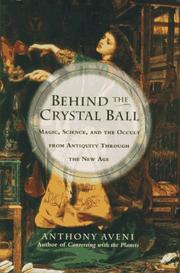Check nearby libraries
Buy this book

In this fascinating exploration of occult practice, Anthony Aveni takes the reader on a whirlwind tour through time and space, traveling from the ancient Tigris-Euphrates river valley to the streets of our modern-day cities. On the way, he catalogs the many ways people have used magic over the millennia in hopes of improving their lives. Consider a page from your ancestors' book of spells: For a headache, pour vinegar on your door hinges.
For warts, wait until the twentieth day after a new moon, rub dirt on the warts while you lie in the road, and gaze up at the moon. Or, if you prefer more modern superstitions and want to be a good pitcher, be like Texas Ranger Mike Griffin and always eat bacon the day before you take to the mound.
.
Professor Aveni argues persuasively that we cannot separate a culture's perception of reality from its times. The ancient priests of Egypt saw the dung beetle, or scarab, as a sign of life not because they were ignorant primitives, but because they were using the available clues in the world around them to map out a greater truth. When Kabbalists sought to discover meaning through the letters in a name or an historical date, they were seeking to satisfy a very deeply held urge.
The ancients sought the same goals we now obtain from science and religion - a clearer picture of humanity's place in the cosmos. How and why has Western thought and scientific inquiry diverged from magic?
- At a time when crystals, channeling, faith healing, earth worship, and transcendental meditation are enjoying a renaissance, the lines between science, magic, and the occult are beginning to blur once again. Comparing Harry Houdini and scientific provocateur Richard Feynman, Professor Aveni asks, "Is magic in the eye of the beholder?"
Check nearby libraries
Buy this book

Previews available in: English
Showing 2 featured editions. View all 2 editions?
| Edition | Availability |
|---|---|
|
1
Behind the crystal ball: magic, science, and the occult from antiquity through the New Age
2002, University Press of Colorado
in English
- Rev. ed.
0870816713 9780870816710
|
cccc
Libraries near you:
WorldCat
|
|
2
Behind the crystal ball: magic, science, and the occult from antiquity through the New Age
1996, Times Books
Hardcover
in English
- 1st ed.
0812924150 9780812924152
|
aaaa
Libraries near you:
WorldCat
|
Book Details
Table of Contents
Edition Notes
Includes bibliographical references (p. 377-389) and index.
Classifications
The Physical Object
ID Numbers
Source records
Scriblio MARC recordIthaca College Library MARC record
Internet Archive item record
marc_openlibraries_sanfranciscopubliclibrary MARC record
Library of Congress MARC record
marc_nuls MARC record
marc_columbia MARC record
Work Description
In this fascinating exploration of occult practice, Anthony Aveni takes the reader on a whirlwind tour through time and space, traveling from the ancient Tigris-Euphrates river valley to the streets of our modern-day cities. On the way, he catalogs the many ways people have used magic over the millennia in hopes of improving their lives. Consider a page from your ancestors' book of spells: For a headache, pour vinegar on your door hinges. For warts, wait until the twentieth day after a new moon, rub dirt on the warts while you lie in the road, and gaze up at the moon. Or, if you prefer more modern superstitions and want to be a good pitcher, be like Texas Ranger Mike Griffin and always eat bacon the day before you take to the mound. Professor Aveni argues persuasively that we cannot separate a culture's perception of reality from its times. The ancient priests of Egypt saw the dung beetle, or scarab, as a sign of life not because they were ignorant primitives, but because they were using the available clues in the world around them to map out a greater truth. When Kabbalists sought to discover meaning through the letters in a name or an historical date, they were seeking to satisfy a very deeply held urge. The ancients sought the same goals we now obtain from science and religion - a clearer picture of humanity's place in the cosmos. How and why has Western thought and scientific inquiry diverged from magic? At a time when crystals, channeling, faith healing, earth worship, and transcendental meditation are enjoying a renaissance, the lines between science, magic, and the occult are beginning to blur once again. Comparing Harry Houdini and scientific provocateur Richard Feynman, Professor Aveni asks, "Is magic in the eye of the beholder?" - Jacket flap.
Links outside Open Library
Community Reviews (0)
Feedback?| August 6, 2021 | Edited by New York Times Bestsellers Bot | Add NYT review links |
| August 19, 2020 | Edited by ImportBot | import existing book |
| February 13, 2020 | Edited by MARC Bot | remove fake subjects |
| July 22, 2017 | Edited by Mek | adding subject: In library |
| December 10, 2009 | Created by WorkBot | add works page |
















